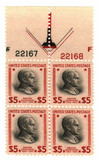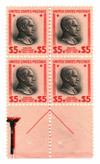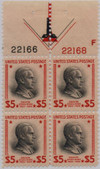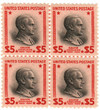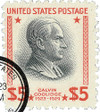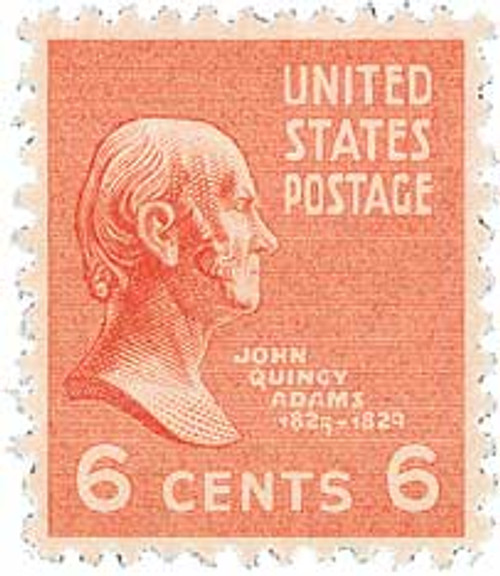
# 834 - 1938 $5 Coolidge
$5 Coolidge
1938 Presidential Series
City: Washington, DC
Quantity: 9,318,026
Printed by: Bureau of Engraving and Printing
Printing Method: Flat plate
Perforations: 11
Color: Carmine and black
Birth Of Calvin Coolidge
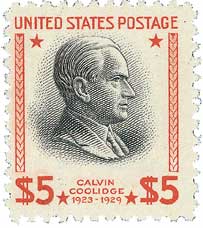
John Calvin Coolidge Jr. was born on Independence Day, July 4, 1872. He spent his early years in the New England town of Plymouth Notch, Vermont.
When Coolidge was 19, he enrolled in Amherst College in Massachusetts. While there, an essay he submitted to a contest sponsored by the National Society of the Sons of the American Revolution won a gold medal. In his senior year, Coolidge was chosen by his classmates to deliver the Grove Oration, a humorous speech given at graduation.
In 1897, Coolidge was admitted to the Massachusetts bar and opened his own law office the following year in nearby Northampton. The same year, Coolidge began his political career on the Northampton, Massachusetts, City Council.
During the start of his political and law careers, Coolidge met Grace Goodhue, a teacher at the local school for the deaf. They were married in 1905. After serving in a few positions in Northampton’s government, Coolidge had his first political defeat when he lost a bid for the school board. He later found out some people voted against him because he had no children of his own.
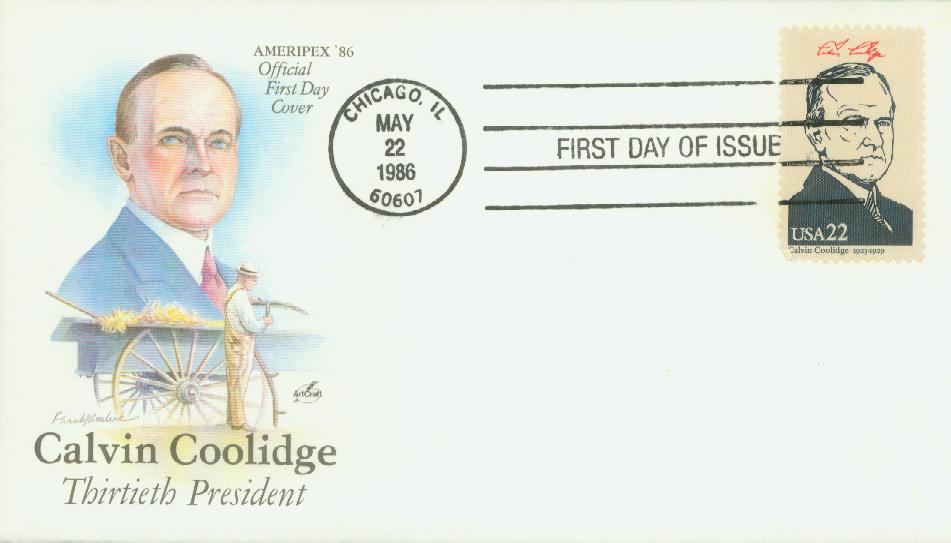
In 1906, Coolidge was elected to the Massachusetts House of Representatives, where he served for two one-year terms. During this time, he supported women’s voting rights and the direct election of senators. Rather than running for a third term, Coolidge returned to Northampton and became its mayor. He again held the office for two one-year terms, increasing teachers’ salaries and lowering the city’s debt.
Coolidge returned to Boston in 1912 as a state senator. He was elected to four terms, serving as president of the state senate the final year. In January 1914, Coolidge delivered a speech entitled “Have Faith in Massachusetts,” which summed up his philosophy of government. When it was published, it increased his reputation in Massachusetts and around the country.
Continuing to climb the political ladder, Coolidge was elected lieutenant governor for three terms. In 1918, he set his sights on the governor’s office. He ran a successful campaign based on his record of smaller state budgets, supporting women’s voting rights, and US involvement in World War I.
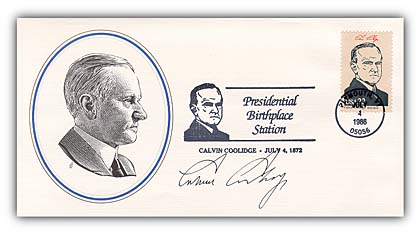
As governor, Coolidge gained national attention because of his response to a strike by Boston policemen. When the police went on strike, violence spread through the city. Coolidge called on the National Guard, the commissioner fired all the strikers, and Coolidge called for the recruitment of a new police force. In a telegram to American Federation of Labor leader Samuel Gompers, the governor said, “There is no right to strike against the public safety by anyone, anywhere, any time.”
In addition to his swift actions during the strike, Coolidge made the government more efficient by reducing the state’s expenditures by four million dollars. He also signed a bill reducing the workweek for women and children to 48 hours, supported a cost-of-living increase for public workers, and gave a $100 bonus to Massachusetts’ veterans of World War I. He also vetoed a bill that would have increased legislators’ salary by 50 percent.
At the 1920 Republican National Convention, Senator Warren Harding was selected for president after ten ballots, but the vice presidential spot was still undecided. A delegate from Oregon, who had read Coolidge’s “Have Faith in Massachusetts” speech, suggested Calvin for the post. The idea quickly caught on and he found himself the surprise nominee for vice president.
In the coming months, Harding ran his famous “front-porch” campaign, letting the voters and reporters come to him. Meanwhile, Coolidge traveled to New England and the Upper South relaying the party’s platform. On November 2, 1920, the Republicans were victorious, winning every state outside the South.
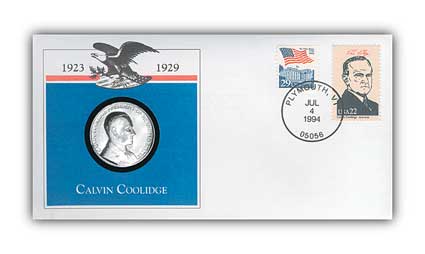
The position of vice president carried few duties in the early 20th century. Coolidge attended Cabinet meetings, the first in his post to do so. He traveled the country giving speeches and attended Washington parties with his wife, Grace. Though Coolidge enjoyed speaking in public, he was not comfortable making small talk. He was given the nickname “Silent Cal” during this time.
In August 1923, President Harding was on a speaking tour in the West when he died unexpectedly. The Coolidge’s were visiting Calvin’s Vermont family home, which had no electricity or telephone. A messenger sent to the house in the middle of the night made the vice president aware of the news. His father, a notary public, administered the oath of office at 2:47 a.m. on August 3, then Coolidge went back to bed. The next day, he traveled to Washington to assume his new duties. A judge swore in Coolidge again because some questioned whether a state notary had the right to give a presidential oath.
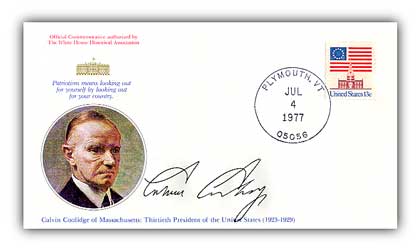
Coolidge felt it was his duty to carry on with Harding’s administration until the end of the term. On December 6, he gave a speech before Congress that reflected many of the former president’s views. Coolidge supported immigration restrictions and government intervention in Pennsylvania coal strikes. This speech was broadcast over the radio, the first time for a US president.
While finishing out Harding’s term, Coolidge signed the Indian Citizenship Act in June. It granted full US citizenship to all Native Americans while maintaining their right to their tribal lands. The same month, the president signed the Revenue Act of 1924, which decreased personal income tax rates, increased estate taxes, and reduced the federal debt.
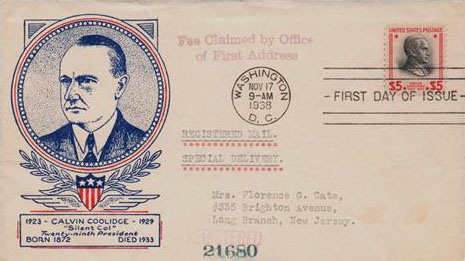
Coolidge was re-elected in 1924, and maintained a connection with the American people through radio messages and interviews. During his presidency, he held 520 press conferences, spoke on the radio at least once a month, and posed for photographs. Coolidge was the first president to appear in a talking newsreel. He enjoyed making people laugh, but was serious when the situation called for it.
The president still respected the rights of states to govern themselves and led his administration in that way. He felt, “What we need is not more Federal Government but better local government.” As a result, the president did little to regulate business, leaving it in the hands of states. He reduced taxes and government spending, reducing the debt as he had done as governor.
As a result of America’s involvement in World War I, the nation held an increased role in world affairs. Coolidge wanted to increase trade with foreign countries while avoiding alliances that may force the US into another war. He did not support joining the League of Nations but supported joining the World Court. One of the president’s best-known foreign policy accomplishments was the Kellogg-Briand Pact.
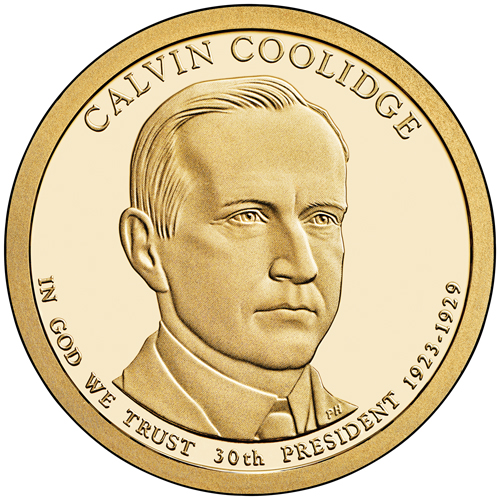
In the summer of 1927, Coolidge announced he wouldn’t run for president the following year. He felt another term would be too long for one man to be in the office. Coolidge and his wife retired to Northampton. In addition to writing his memoirs, the former president had a syndicated newspaper column and spent time on his boat. He also served on the boards of companies and foundations. In 1932, some Republicans discussed drafting Coolidge for their nominee instead of then-president Herbert Hoover. Coolidge refused and supported Hoover in his campaign.
Toward the end of his life, Calvin Coolidge told a friend, “I feel I no longer fit in with these times.” Shortly after that, he died of a heart attack at his home on January 5, 1933. President Hoover declared 30 days of national mourning for the popular former leader. Years later, Hoover wrote, “Any summation of Mr. Coolidge’s services to the country must conclude that America is a better place for his having lived in it.”
$5 Coolidge
1938 Presidential Series
City: Washington, DC
Quantity: 9,318,026
Printed by: Bureau of Engraving and Printing
Printing Method: Flat plate
Perforations: 11
Color: Carmine and black
Birth Of Calvin Coolidge

John Calvin Coolidge Jr. was born on Independence Day, July 4, 1872. He spent his early years in the New England town of Plymouth Notch, Vermont.
When Coolidge was 19, he enrolled in Amherst College in Massachusetts. While there, an essay he submitted to a contest sponsored by the National Society of the Sons of the American Revolution won a gold medal. In his senior year, Coolidge was chosen by his classmates to deliver the Grove Oration, a humorous speech given at graduation.
In 1897, Coolidge was admitted to the Massachusetts bar and opened his own law office the following year in nearby Northampton. The same year, Coolidge began his political career on the Northampton, Massachusetts, City Council.
During the start of his political and law careers, Coolidge met Grace Goodhue, a teacher at the local school for the deaf. They were married in 1905. After serving in a few positions in Northampton’s government, Coolidge had his first political defeat when he lost a bid for the school board. He later found out some people voted against him because he had no children of his own.

In 1906, Coolidge was elected to the Massachusetts House of Representatives, where he served for two one-year terms. During this time, he supported women’s voting rights and the direct election of senators. Rather than running for a third term, Coolidge returned to Northampton and became its mayor. He again held the office for two one-year terms, increasing teachers’ salaries and lowering the city’s debt.
Coolidge returned to Boston in 1912 as a state senator. He was elected to four terms, serving as president of the state senate the final year. In January 1914, Coolidge delivered a speech entitled “Have Faith in Massachusetts,” which summed up his philosophy of government. When it was published, it increased his reputation in Massachusetts and around the country.
Continuing to climb the political ladder, Coolidge was elected lieutenant governor for three terms. In 1918, he set his sights on the governor’s office. He ran a successful campaign based on his record of smaller state budgets, supporting women’s voting rights, and US involvement in World War I.

As governor, Coolidge gained national attention because of his response to a strike by Boston policemen. When the police went on strike, violence spread through the city. Coolidge called on the National Guard, the commissioner fired all the strikers, and Coolidge called for the recruitment of a new police force. In a telegram to American Federation of Labor leader Samuel Gompers, the governor said, “There is no right to strike against the public safety by anyone, anywhere, any time.”
In addition to his swift actions during the strike, Coolidge made the government more efficient by reducing the state’s expenditures by four million dollars. He also signed a bill reducing the workweek for women and children to 48 hours, supported a cost-of-living increase for public workers, and gave a $100 bonus to Massachusetts’ veterans of World War I. He also vetoed a bill that would have increased legislators’ salary by 50 percent.
At the 1920 Republican National Convention, Senator Warren Harding was selected for president after ten ballots, but the vice presidential spot was still undecided. A delegate from Oregon, who had read Coolidge’s “Have Faith in Massachusetts” speech, suggested Calvin for the post. The idea quickly caught on and he found himself the surprise nominee for vice president.
In the coming months, Harding ran his famous “front-porch” campaign, letting the voters and reporters come to him. Meanwhile, Coolidge traveled to New England and the Upper South relaying the party’s platform. On November 2, 1920, the Republicans were victorious, winning every state outside the South.

The position of vice president carried few duties in the early 20th century. Coolidge attended Cabinet meetings, the first in his post to do so. He traveled the country giving speeches and attended Washington parties with his wife, Grace. Though Coolidge enjoyed speaking in public, he was not comfortable making small talk. He was given the nickname “Silent Cal” during this time.
In August 1923, President Harding was on a speaking tour in the West when he died unexpectedly. The Coolidge’s were visiting Calvin’s Vermont family home, which had no electricity or telephone. A messenger sent to the house in the middle of the night made the vice president aware of the news. His father, a notary public, administered the oath of office at 2:47 a.m. on August 3, then Coolidge went back to bed. The next day, he traveled to Washington to assume his new duties. A judge swore in Coolidge again because some questioned whether a state notary had the right to give a presidential oath.

Coolidge felt it was his duty to carry on with Harding’s administration until the end of the term. On December 6, he gave a speech before Congress that reflected many of the former president’s views. Coolidge supported immigration restrictions and government intervention in Pennsylvania coal strikes. This speech was broadcast over the radio, the first time for a US president.
While finishing out Harding’s term, Coolidge signed the Indian Citizenship Act in June. It granted full US citizenship to all Native Americans while maintaining their right to their tribal lands. The same month, the president signed the Revenue Act of 1924, which decreased personal income tax rates, increased estate taxes, and reduced the federal debt.

Coolidge was re-elected in 1924, and maintained a connection with the American people through radio messages and interviews. During his presidency, he held 520 press conferences, spoke on the radio at least once a month, and posed for photographs. Coolidge was the first president to appear in a talking newsreel. He enjoyed making people laugh, but was serious when the situation called for it.
The president still respected the rights of states to govern themselves and led his administration in that way. He felt, “What we need is not more Federal Government but better local government.” As a result, the president did little to regulate business, leaving it in the hands of states. He reduced taxes and government spending, reducing the debt as he had done as governor.
As a result of America’s involvement in World War I, the nation held an increased role in world affairs. Coolidge wanted to increase trade with foreign countries while avoiding alliances that may force the US into another war. He did not support joining the League of Nations but supported joining the World Court. One of the president’s best-known foreign policy accomplishments was the Kellogg-Briand Pact.

In the summer of 1927, Coolidge announced he wouldn’t run for president the following year. He felt another term would be too long for one man to be in the office. Coolidge and his wife retired to Northampton. In addition to writing his memoirs, the former president had a syndicated newspaper column and spent time on his boat. He also served on the boards of companies and foundations. In 1932, some Republicans discussed drafting Coolidge for their nominee instead of then-president Herbert Hoover. Coolidge refused and supported Hoover in his campaign.
Toward the end of his life, Calvin Coolidge told a friend, “I feel I no longer fit in with these times.” Shortly after that, he died of a heart attack at his home on January 5, 1933. President Hoover declared 30 days of national mourning for the popular former leader. Years later, Hoover wrote, “Any summation of Mr. Coolidge’s services to the country must conclude that America is a better place for his having lived in it.”




